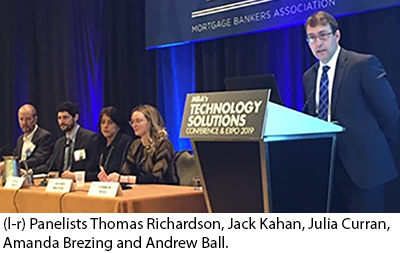
The (Slow) Return of Private-Label Securitization
DALLAS–After years of false starts, the private-label securitization market is finally showing signs of life–albeit not at levels in which anyone appears to be happy, or confident.
“Today, the private-label securitization market is growing,” said Andrew Ball, Senior Vice President of Secondary Markets with BB&T, Raleigh, N.C., and Chairman of the MBA Capital Markets and Secondary Markets Committee. “But it’s still somewhat limited.”
 Panelists here at the recent Mortgage Bankers Association’s Technology Solutions Conference & Expo sounded hopeful about future growth in the private-label securitization market, but remained skeptical in the short term.
Panelists here at the recent Mortgage Bankers Association’s Technology Solutions Conference & Expo sounded hopeful about future growth in the private-label securitization market, but remained skeptical in the short term.
“We need more ample supply,” said Amanda Brezing, Executive Director of Non-Agency Trading with JPMorgan Chase, New York, “For bank originators, what is being originated is not being moved into the secondary market. Many banks are currently retaining servicing.”
Constraints happen on the demand side as well, Brezing said. “The process is very complicated and highly regulated. We also see liquidity issues, and even though those who participate are rewarded for their risk with higher yields, many believe that the rewards are not high enough.”
“Economics are creating somewhat of a vicious cycle,” said Jack Kahan, Managing Director of RMBS with Kroll Bond Rating Agency, New York. “It’s been difficult to see movement on the supply or demand side–they’re waiting for each other to take the first step.”
Kahan noted while last year was a “banner” year for private-label securitization issuance, investor appetite remains low. The question remains, ‘what can the market support?'”
Kahan expressed pessimism that the June 3 implementation of the GSEs’ Common Securitization Platform would result in more private-label securitization. “Unless forced, I’m not sure that the platform would encourage more PLS, because the market hasn’t necessarily responded to other incentives before now,” he said.
“There’s a misunderstanding as to whether there is a true standardization of data,” said Julia Curran, Director of Product and Client Solutions with American Mortgage Consultants Inc., Princeton, N.J. “The data doesn’t take into account a lot of the PLS data, and it’s inconsistent among ratings agencies, who might define the data in a different way.”
With newer products, Curran added, the question arises as to what data points need to be taken into consideration “and whether they need to be weighted and considered differently.”
“Data is the most important consideration in the process,” said Thomas Richardson, Chief Technology Officer with Redwood Trust Inc., Englewood, Colo. “When you get the data, the clock starts ticking as to whether or not you are going to securitize a loan or a pool of loans. If you don’t have clean data, you can’t present a proposal to secure a loan without any confidence.”
“The three most important elements for those who want to get into the PLS market are data, data and data,” Richardson added. “And the fourth element is implementation. Technology is important throughout the process. and you want to have an efficient process, so that when questions arise–some which might have nothing to do with data–you have to have the answers. It’s like going to a car dealer and asking if the back seats have heating. If you can’t answer a question quickly, such as ‘how many of your properties are in a FEMA disaster zone,’ then you aren’t going to generate confidence in your processes.”
Kahan said mainstream single-source verification of data remains a long way off. “It’s starting to happen in the GSE space, and it has to move that way,” he said. “The GSEs appear to be moving the market that way.”
“What the GSEs are trying to do is improve the borrower experience and increase efficiencies,” Brezing said. “This is a very positive trend for the market and it’s how the market should be moving.”
Curran said use of eNotes in the PLS process remains spotty. “I’m not sure there’s a real comfort level yet, but I think it’s a matter of adoption,” she said. “We haven’t seen any yet, but Fannie Mae and Freddie Mac are adopting them and they are going to drive the process.”
“It’s no longer an adoption process; it’s a comfort process,” Richardson added.
